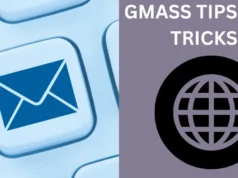A digital illustration of an overflowing inbox overflowing with emails. Each email is represented as a colourful envelope.Is Your Email Secretly Stealing Storage Space? A shocked expression appears on a computer monitor screen next to the inbox.
The relentless tide of emails can quickly transform your inbox into a digital battlefield, overflowing with messages and threatening to disrupt your entire digital ecosystem. But have you ever considered the hidden cost of this email overload?
Lurking beneath the surface of those unread messages and lengthy reply chains could be a storage monster, silently devouring your precious cloud storage space. Yes, you read that right – emails, those seemingly innocuous messages, can be sneaky storage gobblers, contributing to a hidden “gigabyte graveyard” within your cloud account.
The Never ending Inbox: Drowning in Emails or Data?
Imagine a world where every email you receive occupies mental space and eats away at your available storage quota. This might sound like a scene from a dystopian tech thriller, but for many of us, it’s a reality. Our inboxes overflow with promotional offers, social updates, and work-related messages, creating a digital overwhelm. But the actual danger lies beneath the surface.
Each email, with its attachments and hidden data, contributes to a growing storage burden that can eventually lead to limitations and restrictions within your cloud storage plan.
Unveiling the Storage Mystery: Is Your Email Secretly Stealing Storage Space?
The question of whether emails take up space might seem like a no-brainer. Of course, they do. But the true revelation lies in the sheer storage volume they can consume. What seems like a harmless message can quickly snowball into a storage nightmare, especially considering the ever-increasing number of attachments like photos, videos, and large documents often accompanying emails. – you might be sending more than just a message; you could send your precious storage space on a one-way trip to oblivion.
Understanding Email Storage: Demystifying Where Emails Reside and How They Devour Space
The revelation that emails occupy storage space might be surprising, but understanding the mechanics behind this hidden phenomenon is crucial. Let’s delve into the digital ecosystem and explore the world of email storage, uncovering the secrets of where your messages reside and how they silently consume your precious cloud space.
The Cloud Storage Revolution: Where Do Emails Live?
Gone are the days of clunky inboxes residing solely on your personal computer. The rise of cloud-based email services like Gmail, Outlook, and Yahoo Mail has revolutionized how we access and manage our emails. These services offer to store and retrieve your messages from anywhere in the world, but this convenience comes at a cost – storage space.
When you send or receive an email, it’s not simply vanishing into the digital ether; it’s finding a cosy corner within the vast server farms of your chosen email provider. These virtual warehouses store your emails, attachments, and other associated data, and just like any physical storage unit, they have limitations.
Breaking Down Email Size: Gigabytes in Disguise
The seemingly innocuous text-based emails you receive might appear harmless from a storage perspective. However, even plain text messages contribute a small amount of data. The real culprits, however, are the sneaky attachments that often accompany emails. Photos, videos, presentations, and other digital files can quickly balloon the size of an email, transforming it from a kilobyte-sized message into a megabyte or even a gigabyte monster.
Consider a typical vacation email exchange – a few photos shared between friends can easily consume several megabytes of storage space. Now, multiply that by hundreds or even thousands of emails over time, and you start to understand how your inbox can quietly morph into a storage-hogging behemoth.
How To Check storage in Android
Attachments: The Storage Hogs of the Inbox
While text-based emails contribute a small amount to your storage footprint, attachments are the undisputed heavyweight champions for email storage consumption. These digital hitchhikers can range from innocent-looking documents to memory-munching multimedia files.
A single high-resolution photo attached to an email can quickly devour several megabytes of space, and video attachments can tip the scales even further. The more emails you receive with hefty attachments, the faster your precious cloud storage allotment dwindles. So, the next time you consider attaching a large file to an email, remember that you might be gifting your recipient a digital present while simultaneously contributing to your storage future.
The Impact of Email Storage: When Gigabytes Cast Long Shadows
The revelation that emails gobble up storage space isn’t just a technical curiosity; it has real-world consequences that can disrupt your digital workflow. Let’s explore the ripple effects of a storage-hungry inbox, uncovering how seemingly harmless emails can snowball into a problem that impacts not just your email but your entire digital ecosystem.
Inbox Overload: When Emails Tip the Storage Scales
The constant influx of emails can quickly transform your inbox from a communication hub into a digital landfill. Each unread message, lingering reply chain, and forgotten email attachment contributes to the ever-growing storage burden. Before you know it, you’ve hit your storage quota, and a notification pops up like a digital grim reaper, informing you that your email graveyard has reached capacity.
This can lead to a frustrating situation where incoming emails bounce back, attachments fail to upload, and your carefully crafted digital life grinds to a halt.
Limited Storage Blues: Feeling the Pinch of a Full Cloud Drive
The consequences of a storage-laden inbox extend far beyond the confines of your email. Most cloud storage services like Gmail or Outlook offer a free allocation of storage space that encompasses not just your email but also your documents, photos, and other digital files.
When your email storage reaches its limit, it starts to eat into this shared pool, potentially impacting your ability to store other important files. Imagine wanting to upload a cherished family video or a crucial work document, only to be met with a dreaded “storage full” message. This can create a domino effect, forcing you to decide what digital treasures to keep and what to delete.
The Domino Effect: How Email Storage Affects Other Files
The impact of a storage-hungry inbox continues beyond hindering your ability to upload new files. A complete cloud storage quota can also disrupt essential functionalities within your email service. For instance, automatic email backup features might halt, jeopardizing your ability to recover crucial messages in case of accidental deletion.
Additionally, features like spam filtering and malware detection might become less effective due to limited storage resources. A neglected inbox can create a cascading effect, causing problems beyond email communication.
Taming the Storage Beast: Strategies for Email Management and Reclaiming Your Digital Territory
The overflowing inbox, a battleground of unread messages and forgotten attachments, no longer needs to be your digital reality. You can transform your inbox from a storage-hogging monster into a streamlined communication hub by implementing effective email management strategies. Let’s explore some ninja-worthy tactics to conquer the email clutter and reclaim your precious cloud storage space.
Declutter Your Inbox: The Art of Letting Go
The first step to email management nirvana is embracing the power of decluttering. Just like a cluttered physical space can feel overwhelming, a digital inbox overflowing with outdated messages can create a sense of digital claustrophobia. Schedule regular decluttering sessions where you ruthlessly (but strategically) delete old emails you no longer need. Utilize search filters to target specific categories of emails, such as old promotional offers or social updates. Remember, letting go of these digital ghosts doesn’t erase their importance; it frees up valuable storage space for what truly matters.
Embrace the Power of Delete: Release Yourself from Email Purgatory
Many of us fall victim to the itsuka kitto – Japanese for ‘someday maybe’).” mentality regarding emails. We hoard messages with the faint hope that we’ll need them someday, creating a digital purgatory where emails languish for years, silently consuming storage space. Fight the urge to procrastinate. If you haven’t needed an email in months or even years, chances are you won’t. Utilize the “delete” button with confidence, and remember – deleting an email doesn’t erase its importance; it simply acknowledges that its usefulness has expired.
( hyögu suru – Japanese for “Utilize”) Archiving: Preserving Memories Without the Storage Burden
Not all emails deserve the harsh finality of deletion. Perhaps you have sentimental emails from friends and family or work-related documents you might need for future reference. This is where the magic of archiving comes into play. Archiving moves emails out of your inbox and into a designated storage area. They’re accessible if needed but no longer clutter your inbox or contribute to your storage quota.
Think of it as creating a digital attic for your email memories, allowing you to preserve the past without sacrificing precious storage space in the present.
Advanced Techniques for Email Storage Optimization: Unlocking the Secrets of Maximum Efficiency
Conquering the basic principles of email management is a solid foundation, but for the genuinely storage-savvy user, a treasure trove of advanced techniques is waiting to be explored. These ninja-level tactics can help you squeeze every last drop of efficiency out of your email storage, ensuring your inbox remains a lean, mean communication machine.
Attachment Tamers: Compressing Files for Reduced Storage Footprint
As we’ve established, attachments are the primary culprits behind email storage woes. But fear not; there are ways to combat these digital space invaders. Many email services offer built-in attachment compression features that significantly reduce the file size of images, documents, and presentations before sending. Think of it as putting your attachments on a digital diet, allowing them to retain their functionality while consuming less storage space. Additionally, exploring online compression tools can further shrink hefty attachments, ensuring they don’t become storage-hogging roadblocks in your email communication.
Cloud Storage Spring Cleaning: Utilize Different Cloud Services Strategically
Many of us rely solely on the free storage space offered by our primary email provider. However, the digital world provides various cloud storage options with free and paid plans. Consider utilizing different cloud storage services for multiple purposes. For instance, you can store large work documents on a dedicated cloud storage platform like Google Drive or Dropbox while keeping your email attachments confined to your email provider’s allocated space. This strategic approach distributes the storage burden, preventing your inbox from becoming a catch-all for every digital file that crosses your path.
Leverage Email Filters: Automate the Decluttering Process
Who needs manual labour when you have the power of automation at your fingertips? Most email services allow you to create powerful filters that automatically declutter your inbox and keep your storage space in check. Imagine setting up a filter that whisks away old social media notifications or automatically archives emails from specific senders after a certain period. These automated workflows become your digital janitorial staff; embracing these advanced techniques allows you to transform your email management from a reactive struggle to a proactive system, ensuring your precious storage space is continually optimized for peak performance.
Conclusion: From Inbox Overlord to Storage Superhero – Reclaiming Your Digital Dominion
The revelation that emails gobble up storage space might have come as a surprise, but fear not. Empowered with how emails impact your digital ecosystem, you can transform from a bewildered inbox dweller into a storage-savvy superhero. By implementing the abovementioned strategies, you can reclaim your digital territory and ensure your email habits no longer lead to storage limitations.
Taking Control of Your Storage Destiny: From Inbox Zero to Storage Hero
Imagine a world where your inbox is a haven of organization, free from the clutter of forgotten emails and hefty attachments. By embracing the art of decluttering, archiving, and utilizing advanced storage optimization techniques, you can achieve “Inbox Zero” – a streamlined communication hub that consumes minimal storage space. This newfound control over your digital domain empowers you to focus on what truly matters – clear communication and efficient workflows, not the tyranny of a storage-hungry inbox.
Embracing Efficiency: Building a Sustainable Storage Management System
Keep email management from becoming a never ending chore. Establishing a sustainable storage management system ensures your inbox remains organized and efficient over the long term. Schedule regular decluttering sessions, leverage the power of automation with email filters, and explore alternative storage solutions for hefty attachments.
Remember, a little planning and proactive management go a long way in preventing your inbox from morphing back into a storage-sucking monster. So, take charge of your email habits, embrace the power of storage optimization, and reclaim your rightful place as the ruler of your digital domain.
Have you ever wondered if your overflowing inbox is secretly eating away at your precious storage space? Discover the truth about email storage and learn how to reclaim your digital territory.
Why Timely Fast Delivery Email Wins












